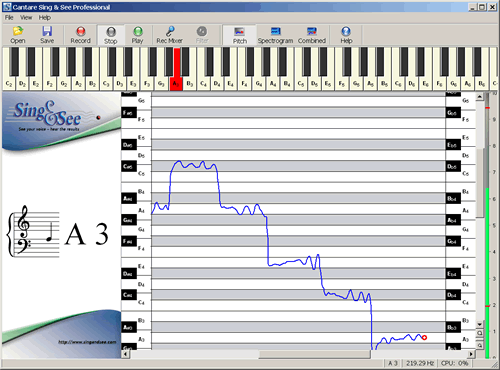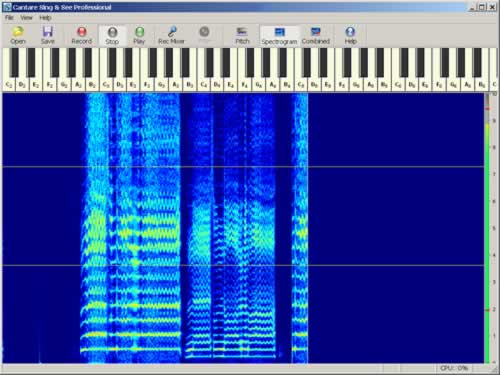Using Sing & See to improve your singing
Sing & See is designed to meet the needs of singers and teachers working in all vocal styles and genres. It gives an almost instant visual representation of the singing voice, allowing singers to see the shape of their voice while they sing, and then to listen to it being replayed - again seeing it directly on the screen.
The software can be used as an aid in practice - showing you how you are maintaining pitch, volume, or vocal colour.
Pitch
In the pitch view, the exact pitch of your voice is shown while you sing. You can see what note you are singing on the piano keyboard and stave - this can help in learning to identify the sound of your voice with specific notes. You also see a line that mirrors how your pitch moves with time as you sing a single note or a range of notes. The continuous line allows you to see visually the control of pitch, and even details such as vibrato and how easily you move from one pitch to another.

The pitch tracing shows you how accurately you achieve each pitch, how
smooth the onset to the note is, and also how the vibrato in your voice
appears.
Spectrogram
The spectrogram shows you the timbre of your voice - the visual display represents the harmonic structures in the voice and how it changes while you're singing. This display provides a visually rich picture of the voice's character over time, including vowel shapes, singer’s formant, twang, breathiness, voice onset, vibrato, and pitch variation.
In singing, the spectrogram shows how the pattern of harmonics change as you sing different vowels or otherwise change the timbre of your voice. It also shows how "bright" your voice is (the so-called "singer's formant" or "ring") - this comes up as a band of bright color in the middle part of the display (between the two horizontal lines).

The spectrogram shows the pattern of harmonics in your voice. Time proceeds horizontally, and higher harmonics are represented higher on the vertical axis. The brightness of the color indicates the strength of the harmonic at that point in time and frequency. The two horizontal lines show 2kHz and 4kHz - below 2kHz the patterns are generally dependent on what vowel you're singing; while between 2 and 4kHz is the region of "singer's formant" (sometimes called "twang").
 Find
out more about Sing & See software for singing training.
Find
out more about Sing & See software for singing training.
